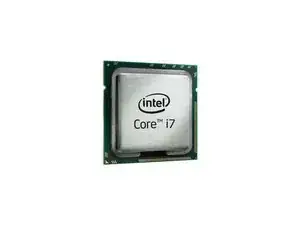Introduction
I noticed my iMac being slow. I thought it was just me? You know, after a few iterations of upgrading operating systems etc. Things slow down. That's just what happens. So I put clean-installed SSD in it. I done that previously for my aging MacBook Pro with fantastic results. To my dismay my iMac still felt slow. So I looked around for a benchmarking utility to quantify this feeling I had. I found geekbench 3. That software confirmed that my iMac was running way slower than it should - less than half the speed you'd expect.
Tools
Parts
-
-
Geekbench 3 32-bit test. Geekbench 3 allows you to browse results from others with similar computers, so it was easy to see that something was wrong with my mine.
-
-
-
Naturally I asked on the iFixit forums and elsewhere about what might be wrong. Though helpful, the forums spun off in irrelevant directions, mostly talking about hard drive install issues. Geekbench 3 dosen't benchmark hard drives so...
-
-
-
There's loads of videos and iFixit repair guides to show you how to get in to your iMac so I'm not going to go over that ground.
-
Be super careful with that ridiculously flimsy ribbon cable on the top left
-
-
-
To remove the mother board undo the Torx T10 screws shown in the yellow circles. (There's one behind a cable bottom right)
-
Hopefully I've circled them all. (undo any screw on the mother board that has a white circle printed on the board.)
-
Oh, you'll also have to yank out the infra-red sensor behind the Apple logo. Just pull up. It's spring loaded in there...
-
-
-
Label all the cables as you remove them. Work logically. I started top right and went anti clockwise. (this helps to know you haven't missed any when you reassemble.)
-
Theres 2 that have the gold contacts in the clip facing the motherboard... I noted that too. Probably important not to turn them around?
-
-
-
Once you have the motherboard out you should have something that looks a bit like this.
-
The CPU is the one that's mounted at the funky 45° angle. Bottom left on the overall photo.
-
On the side of the motherboard that normally faces the back case there's huge Phillips head Spring loaded screws holding the heatsink on, but on the other side the usual torx T10 back to back with the Phillips head things. Four to undo.
-
When you have that heatsink off you need to clean the heatsink side with some thermal cleaner. Fixit sell it.
-
The i7 processor is socketed and easy to unclip. There's a spring loaded handle top right orientation in the overall photo although you can't see it because of the heat sink. In the 4th image it's visible to the left of the socket.
-
The old processor lifts out and the new processor drops in be careful to align the processors identically. One corner has an arrow on it.
-
Use new thermal paste between the processor and the heatsink. IFixit sell it.
-
To reassemble your device, follow these instructions in reverse order.
27 comments
Tried it out. Unfortunately my iMac Intel 27". EMC 2309 (Late 2009, Core 2 Duo 3.06 GHZ) Had an older Socket (775).
Bad luck. I did read on blogs some conjecture about weather the processor was socketed or not. It turned out it was socketed, which made it very easy to replace. All I was doing was replacing like-for-like processor. I wasn't trying to upgrade or anything. As you can see from the benchmarks even replacing like-for-like can be advantageous. (also inexpensive because these are not new processors now!)
Perhaps replacing your old processor with a fresh one of the same sort will improve things? It's worth a try if you got this far? It certainly worked for me. It's not fast by modern standards, but totally useable for a 7 year old machine is pretty good I think... Certainly never happened when I had windows machines!
mark -
Walter
how did you find out that you had “iMac Intel 27". EMC 2309 (Late 2009, Core 2 Duo 3.06 GHZ) Had an older Socket (775).”?
I have the same computer with Core 2 Duo 3,06 ghz and I’m considering CPU upgrade to Intel i7 processor.
i just tried a intelcore 2 quad 2.83ghz(q9550s) socket 775...imac wont boot up..it starts,but only got 2leds on..it doesnt go to 3 and nr 4 leds... :(
bleach24 -
I was wondering if a replacement could bring VT-X EPT capabilities, or that is not possible because of the lack of firmware support. My replacement i7 http://ark.intel.com/products/41315/Inte... does support EPT, and still I cannot use it with let's say Dockler for Mac. Any ideas how to fix that?















